Product Assembly
How Contract Assembly Boosts Productivity

When it comes to product design, China has emerged as a global leader, offering innovative solutions and unparalleled manufacturing capabilities. Whether you are an entrepreneur looking to launch a new product or a business aiming to expand into new markets, understanding the intricacies of product design in China is crucial.
In this article, we will explore the essential aspects of product design in China, shedding light on its benefits, challenges, and market trends. So, let’s dive in and unlock the potential that Chinese product design holds for your business.
The Importance of Product Design in China
Product design plays a pivotal role in the success of any business, and China has become a hub for innovative design solutions. With its vast pool of talented designers and cutting-edge technology, China offers businesses a competitive edge in the global market.
Effective product design enables companies to differentiate themselves, create appealing products, and meet the ever-evolving needs of consumers.
Embracing Innovation and Efficiency
China’s product design landscape is characterized by its commitment to innovation and efficiency. Chinese designers leverage advanced technologies and embrace novel ideas to create groundbreaking products.
By collaborating with Chinese design firms, businesses gain access to fresh perspectives, out-of-the-box thinking, and streamlined design processes, leading to faster time-to-market and enhanced competitiveness.
Understanding the Chinese Consumer
To succeed in China’s vast and diverse market, understanding the preferences and expectations of the Chinese consumer is vital. Chinese consumers have distinct tastes, influenced by cultural factors, social trends, and economic conditions.
By incorporating local insights into product design, businesses can tailor their offerings to align with Chinese consumers’ desires, increasing the chances of market success.
Navigating Intellectual Property Rights
Protecting intellectual property (IP) is a concern for businesses operating in any country, and China is no exception. While China has made significant progress in strengthening IP laws and enforcement, challenges still exist.
Engaging with experienced legal counsel and taking proactive measures can help safeguard your designs and inventions throughout the product design process in China.
Collaborating with Local Design Agencies
Collaborating with local design agencies can provide invaluable advantages when entering the Chinese market. These agencies possess in-depth knowledge of the local industry landscape, consumer behavior, and design trends.
By leveraging their expertise and network, businesses can create products that resonate with the Chinese market, improving market penetration and brand perception.
Cultural Sensitivity and Localization
Culture plays a crucial role in product design, and China’s rich cultural heritage demands careful consideration. Adapting your product to reflect cultural preferences, symbolism, and traditions can significantly enhance its appeal to Chinese consumers.
Localization goes beyond language translation and involves tailoring the design elements, packaging, and marketing strategies to align with the cultural sensibilities of the target audience.
Streamlining the Manufacturing Process
China’s reputation as the “world’s factory” stems from its efficient manufacturing capabilities. When embarking on product design in China, it is essential to collaborate closely with manufacturers.
By involving them early in the design process, businesses can benefit from their expertise and optimize the design for manufacturability, ensuring cost-effectiveness and streamlined production.
Overcoming Language and Communication Barriers
Language and communication barriers can pose challenges when working with Chinese partners. Effective communication is vital to ensure clarity, avoid misunderstandings, and maintain productive relationships.
Employing translators, hiring bilingual staff, or partnering with experienced local professionals can help bridge the language gap and foster effective collaboration throughout the product design journey.
Adapting to Changing Market Trends
The Chinese market is dynamic and constantly evolving. Staying abreast of the latest market trends is crucial for successful product design in China.
By analyzing consumer behavior, market research, and emerging technologies, businesses can identify opportunities for innovation, anticipate market demands, and create products that cater to the ever-changing preferences of Chinese consumers.
Ensuring Quality Control and Compliance
Maintaining quality standards and compliance is essential to build trust and protect your brand reputation.
Working closely with manufacturing partners to establish robust quality control processes, conducting regular inspections, and adhering to relevant regulations and certifications are vital steps to ensure that your products meet the required standards and deliver customer satisfaction.
Product design in China offers businesses a gateway to innovation, efficiency, and market success. As the global business landscape continues to evolve, product design in China remains a vital strategy for businesses looking to thrive in a competitive world. You can also choose to work with a manufacturer like Shield Works, one with their own in-house international team of industrial designers and engineers to craft your vision into a concrete reality. Contact us now!
How China Became a Global Leader in PCB Assembly
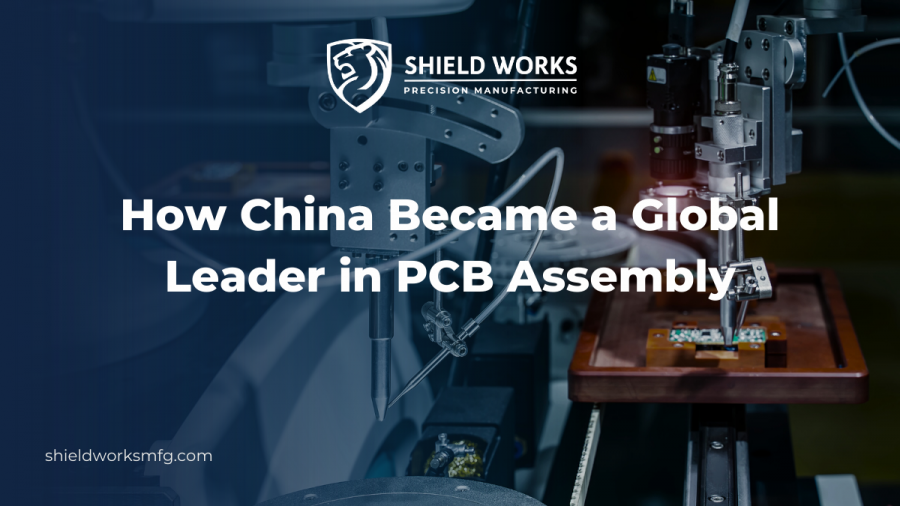
China has made a name for itself as a global leader in PCB assembly. Over the years, many PCB assembly companies and factories have sprung up across the country, enabling it to become a dominant force in the industry. With its high-quality standards, competitive pricing, and reliable infrastructure, China is the go-to destination for companies at home and abroad looking for reliable and cost-effective PCB assembly services.
Today, PCB assembly in China is increasingly sophisticated and efficient, thanks to cutting-edge technologies and dedicated staff employers. As a result, China is an integral part of the international PCB assembly industry, providing a reliable source of high-quality and cost-effective products and services.
In this blog, we will delve deeper into the topic of PCB assembly in China, providing valuable insights into its development and capabilities. Continue reading to expand your knowledge on the subject.
What is PCB Assembly?
A PCB, also known as a Printed Circuit Board, is a crucial component in electronics. Typically green in color, a PCB is a rigid board that securely holds and interconnects electronic components, facilitating their proper functioning within an electronic device.
PCB assembly, or Printed Circuit Board assembly, is the process of populating electronic components onto a printed circuit board (PCB) to create a functional electronic device. PCB assembly is a critical step in the manufacturing process of electronic devices, ranging from consumer electronics, such as smartphones and laptops, to industrial equipment and medical devices. The quality and reliability of the PCB assembly directly impact the overall performance and longevity of the electronic device.
PCB Assembly in China
The electronics industry has experienced exponential growth in recent years. With the advent of advanced technologies, the demand for electronic devices has increased rapidly, and China has been able to cater to this demand effectively. PCB assembly services are one of the core areas of the electronics industry, and China has established itself as a global leader in this domain.
In China, PCB assembly companies typically handle a range of services, including design, prototyping, testing, and mass production. These companies use state-of-the-art equipment and follow international quality standards to produce high-quality PCBs for various applications, such as consumer electronics, automotive, telecommunications, and aerospace.
Many PCB assembly factories in China are located in the southern region, particularly in Shenzhen, which is considered the “Silicon Valley” of China. This city has a large number of electronics manufacturing companies, ranging from small businesses to global brands.
As the demand for electronic devices continues to grow, the demand for PCB assembly services is also on the rise. China is able to provide high-quality PCB assembly services at a competitive price, which has attracted many global companies to outsource their assembly needs to the country.
Factors That Contributed to China’s Success in PCB Assembly
China’s success in PCB assembly is not a coincidence. Several factors have played a significant role in turning China into a global leader in this industry. Let’s take a closer look at some of these factors:
1. Cost Advantage
China’s cost advantage in the manufacturing and assembly industry has been a driving force behind its success and its status as a preferred destination for companies worldwide. One of the primary contributors to China’s cost advantage is its large and abundant labor force. The country boasts a massive population, providing a vast pool of skilled and unskilled workers. This abundant labor supply allows companies to access a diverse range of talents and skills required for manufacturing and assembly processes. Furthermore, the availability of a large labor force helps keep wages relatively low compared to other developed countries, contributing to overall cost savings in the assembly process.
2. Robust Supply Chain
China has developed a highly efficient supply chain network for PCB assembly. The country has a vast network of component suppliers, distributors, and logistics providers that support the assembly process. This efficient supply chain helps to streamline operations, reduce costs associated with sourcing materials, and improve overall productivity.
3. Infrastructure
China’s well-developed manufacturing infrastructure and supportive government policies enable the success of PCB assembly. The country has invested in establishing dedicated industrial parks and manufacturing zones, equipped with modern facilities and infrastructure. This well-developed infrastructure helps streamline processes, optimize logistics, and minimize operational costs.
4. Strong Government Support
The Chinese government has been actively supporting the electronics industry for decades, investing heavily in infrastructure, education, and research and development. This support has played a vital role in building a strong supply chain, reducing costs, and improving quality.
5. Favorable Business Environment
The Chinese government has created a favorable business environment that encourages foreign investment, allowing PCB assembly companies to establish joint ventures and partnerships with Chinese firms. This has enabled these companies to benefit from the vast Chinese market and reduce their costs.
PCB Assembly with Shield Works
The PCB assembly market in China is projected to experience sustained growth and advancements in the coming years, aligning with the expanding electronics industry. Given the persistent demand for electronics, there will be an ongoing requirement for reliable PCB assembly services.
If you are seeking a reliable partner for your PCB assembly requirements, Shield Works is the ideal choice. As a British-owned and managed company, we specialize in delivering high-quality contract manufacturing and product assembly services at competitive rates. Our commitment to excellence is reflected in our meticulous processes that ensure superior quality and consistency from order placement to final delivery. Take the first step today by contacting us for more information. Discover how Shield Works can offer exceptional value for your investment, meeting your PCB assembly needs with utmost precision and reliability.
How Automation Can Help Streamline Your Product Assembly Process?
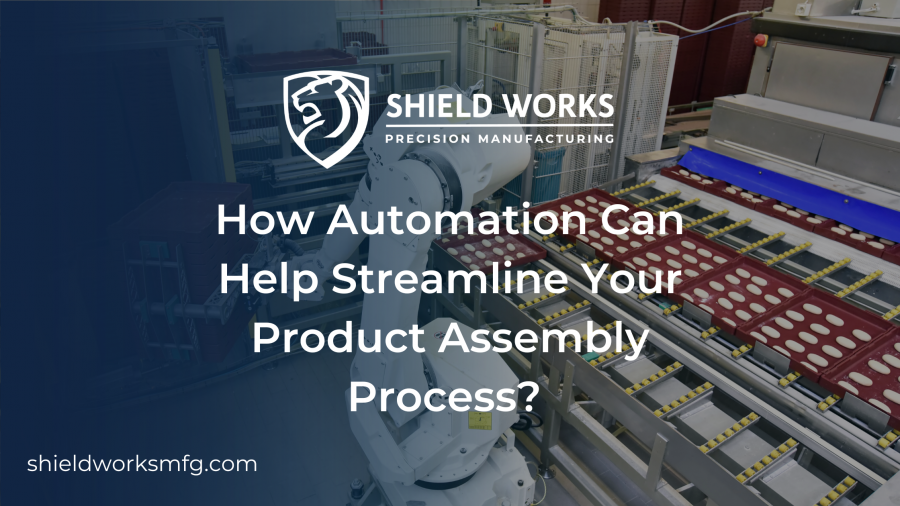
Automation has become an integral part of numerous industries, revolutionizing processes and enhancing productivity. In the realm of product assembly, automation holds immense potential for streamlining operations and improving overall efficiency.
In this article, we will explore how automation can help optimize your product assembly process, allowing you to deliver high-quality products while minimizing costs and time.
Understanding Automation in Product Assembly
Automation in product assembly refers to the use of technology and machinery to perform repetitive tasks that were traditionally carried out by humans.
These tasks can include picking and placing components, tightening screws, performing quality checks, and packaging finished products.
By automating these processes, businesses can eliminate human error, increase production speed, and improve overall accuracy.
Benefits of Automation in Streamlining Product Assembly
- Enhanced Efficiency: Automation significantly improves the speed and accuracy of product assembly, resulting in increased output and reduced production time.
- Reduced Costs: By automating repetitive tasks, businesses can minimize labor costs, as well as reduce errors and rework expenses.
- Improved Quality Control: Automation ensures consistent quality control throughout the assembly process, reducing defects and enhancing customer satisfaction.
- Optimized Resource Utilization: Automated systems can utilize resources more efficiently, allowing businesses to allocate their workforce to more complex and strategic tasks.
- Worker Safety: By automating hazardous or physically demanding tasks, businesses can prioritize worker safety and minimize the risk of accidents or injuries.
Implementing Automation: Best Practices
When integrating automation into your product assembly process, consider the following best practices:
- Thorough Process Analysis: Identify the tasks that can be automated and evaluate their feasibility and potential impact on the overall process.
- Investment Planning: Determine the budget and timeline required for implementing automation, including equipment costs, training, and system integration.
- Collaboration with Experts: Consult with automation specialists and suppliers who can provide valuable insights and recommend suitable solutions for your specific needs.
- Gradual Implementation: Implement automation gradually, starting with smaller-scale projects to test and refine the process before scaling up.
- Training and Workforce Adaptation: Provide proper training to your workforce to ensure smooth adoption of automation technologies and address any concerns or resistance.
- Continuous Monitoring and Improvement: Regularly monitor the automated processes, gather data, and analyze performance to identify areas for further optimization.
Overcoming Challenges in Automating Product Assembly
While automation brings numerous benefits, it also presents challenges that businesses need to address:
- Initial Investment: The upfront cost of automation can be substantial, requiring careful financial planning and evaluation of long-term returns on investment.
- System Integration: Integrating automation systems with existing infrastructure and software can be complex and may require specialized expertise.
- Workforce Adaptation: Some employees may be resistant to change or fear job displacement. Providing proper training and transparent communication is crucial to address these concerns.
- Maintenance and Upkeep: Automated systems require regular maintenance and occasional upgrades, which should be factored into the overall cost and operational planning.
- Flexibility and Scalability: Ensuring that the automated systems are flexible and adaptable to future changes in product design or assembly requirements is essential.
Future Trends in Automation for Product Assembly
The field of automation is constantly evolving, and several trends are shaping the future of product assembly:
- Collaborative Robots: Collaborative robots, also known as cobots, are designed to work alongside humans, enabling safe and efficient collaboration in assembly tasks.
- Artificial Intelligence: AI-powered systems can analyze data, make decisions, and optimize assembly processes in real-time, leading to further improvements in efficiency and quality.
- Internet of Things (IoT) Integration: By connecting assembly line components and machines through IoT, businesses can gather real-time data for predictive maintenance and process optimization.
- Advanced Vision Systems: Vision systems equipped with advanced cameras and sensors can enhance quality control by detecting defects and abnormalities with high accuracy.
- Automation as a Service: Cloud-based automation platforms offer scalable and flexible solutions, allowing businesses to implement automation without significant upfront investments.
Automation is a powerful tool that can revolutionize the product assembly process, enabling businesses to streamline operations, improve efficiency, and deliver high-quality products to their customers.
To stay competitive in the rapidly evolving market, it is crucial for businesses to explore the potential of automation and implement it strategically in their product assembly workflows. Or you can choose to work with a manufacturer that has highly automated their production process, such as Shield Works, one with their own in-house facility and 18 years of industry experience, always looking to innovate their manufacturing expertise. Contact us today!
Exploring Different Types of Product Assembly Options for Your Business

Did you know the business process outsourcing segment in China was worth $15.03 billion in 2021?
Grand View Research says the growth is due to investments in the IT infrastructure of major Chinese cities. There have been similar investments in smaller Chinese cities as well.
Does your company think about product assembly options in China? If so, it pays to explore the various product assembly strategies.
Continue reading to learn about different kinds of product assembly options.
Assemble-to-Order
If you’re considering a China assembly service, one option is the assemble-to-order strategy.
This strategy calls for assembling an inventory of components. When customers place orders, the manufacturer uses the parts to make the products.
The assemble-to-order strategy requires the manufacturer to assemble and dispatch products after receiving orders. It needs to be done fast. Creating an organized inventory is, therefore, essential.
When you partner with a reputable and experienced outsourcer in China, you won’t have anything to worry about. At Shield Works, we’ll make product-order projections based on the following:
- Historical information
- Market conditions
- Macroeconomic trends
Products can be customized by customers since the products are not assembled until after the customers place orders.
It’s one strategy employed by providers of product assembly services.
Make-to-Order
Another product assembly strategy is the make-to-order option. It’s one of the product assembly services in China.
The product assembler can only start the process after receiving confirmation of a client order.
Advantages of the made-to-order method include the following:
- Customization to meet customers’ needs
- Less waste
However, the disadvantages of this manufacturing process include the following:
- Longer wait times
- Higher costs
So, you’ll want to weigh whether the benefits outstrip the disadvantages for your company. You can count on us at Shield Works to give you our honest, professional assessment.
Finding an outsourcing partner with operations in China will offer you a competitive advantage. And you won’t have to sit up at night worrying about your product assembly operations.
Make-to-Stock
The make-to-stock manufacturing strategy is another option. It calls for creating products and stocking them until customers place orders. Demand forecasts, driven by experienced outsourcers, drive this strategy.
There are some drawbacks to this method, such as the following:
- Expenses associated with holding onto unsold inventor
- Potential for stocked products to become obsolete
One manufacturing method you’ll want to consider is the make-to-stock option. It’s a good option if you’re considering product assembly in China.
Get in touch with us at Shield Works Precision Manufacturing. We can consider your situation to determine what strategy best fits your business.
Assembly Simulation and Testing
Yet another assembly option to consider is assembly simulation and testing. It’s about getting things off on the right foot. We conduct assembly trials and process optimization to help the product development cycle.
Before rolling out any project, we’ll work with customers to simulate the assembly process. You can determine expenses and get insights into the effectiveness of the process.
Undergoing this process will help reduce expenses, cut production lead times, and help with quality control.
If you’re considering product assembly in China, don’t overlook assembly simulation and testing. It might be the right option for you.
Disassembly, Re-Assembly, and Repacking Services
We’ll remove the current packaging and put the product in new packaging. You’ll get to choose the new packaging.
This service can be useful if you must repackage for any of the following reasons:
- Products must be inspected before delivery
- Products must be placed in the correct packaging after having been put in the wrong packaging
When you partner with us at Shield Works, we’ll guarantee quick turn-around times for repackaging projects. We can also help with disassembling and reassembling products before repackaging.
Repetitive Manufacturing
Do you want to contact manufacturing in China for help with your product assembly needs? One option is repetitive manufacturing.
It’s a worthwhile manufacturing strategy as it offers repeat production at a consistent and reliable rate.
Repetitive manufacturing requires dedicated production lines to assemble the same product or component. Since the production lines focus on a single product or part, you can scale up or down to meet demand.
Prototype Assembly Projects
Do you require assistance with prototype assembly? If so, we have what you’re looking for. We understand that prototyping is an essential part of the manufacturing process.
You can count on us to build prototypes to optimize solutions. We offer an end-to-end prototyping assembly service. Get in touch to find out how you can take advantage of this service.
Batch Process Manufacturing
This manufacturing process is driven by customer demand. Using this strategy, an outsourcer can create batches of products after getting orders.
After completing the order, the third party will clean up the equipment. That means the equipment will be ready for service when the next batch order arrives.
Companies in the publishing industry tend to gravitate toward the batch process.
Continuous Process Manufacturing
Continuous process manufacturing runs all the time. It mostly focuses on raw materials in the form of liquids, gases, and powders.
So, it’s worth considering if the product is something like peanut butter, tomato sauce, or beverages.
Do You Need Help With Product Assembly?
You can now see that various product assembly options are available. Outsourcing the process to an overseas third party makes sense.
At Shield Works Precision Manufacturing, we have you covered. We have experience helping businesses find suitable outsourcing options. You owe it to yourself to explore the benefits of outsourcing product assembly.
Do you need product assembly, contract manufacturing, OEM manufacturing, warehousing, or distribution services? There are benefits to finding a service provider in China. Need more information? Contact us today to learn more.
Choosing the Right Product Assembly Company: Assembly Locally VS. Assembly in China
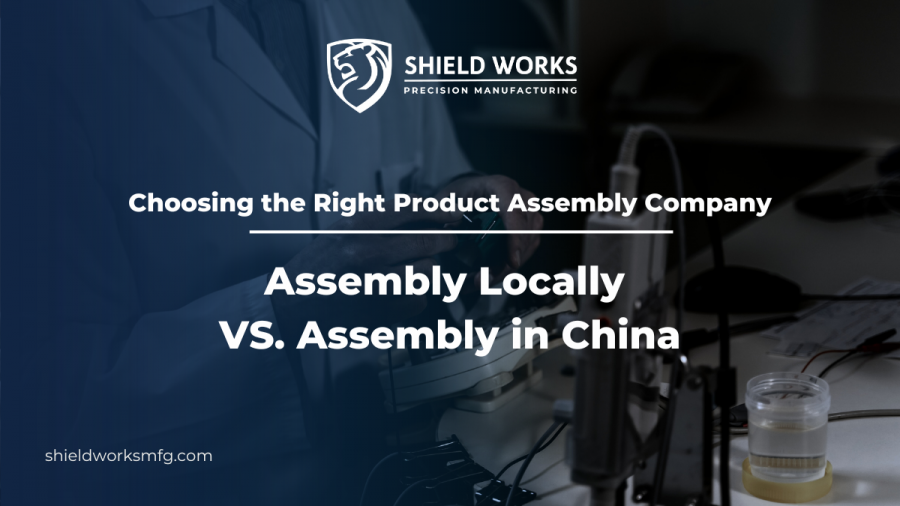
In today’s globalized economy, businesses face crucial decisions when it comes to product assembly. Many companies in the West are continually seeking cost-effective and efficient ways to assemble their products. One of the most significant choices is whether to assemble products locally or outsource the assembly process to other countries in Asia like China. Both local assembly and assembly in China offer distinct advantages and challenges, making it essential for businesses to weigh their options carefully.
In this blog post, we will explore the benefits and drawbacks of both local and overseas product assembly companies to help you decide which option is right for you. Let’s dive right in!
Domestic Assembly VS. Overseas Assembly
Domestic assembly refers to the process of assembling products within the same country where they will be sold or consumed. On the other hand, overseas assembly involves manufacturing and assembling products in a foreign country and then exporting them back to the home country.
Assembly Locally: The Advantages
Easier Factory Audits and Inspections
You can often visit the facility and see firsthand how they assemble your products. When you opt for local assembly, it becomes more convenient and accessible for you to perform thorough inspections during the assembly process.
Communication and Collaboration
Working with a local assembly company facilitates clear and effective communication. You can easily interact with the assembly team, provide instructions, and discuss any modifications or requirements face-to-face. This reduces the chances of miscommunication and ensures that your vision for the product is accurately conveyed.
Faster Turnaround
Local assembly generally results in faster turnaround times since there are no delays associated with shipping products from overseas. This can be particularly beneficial if you have time-sensitive projects or need to respond quickly to market demands.
Reduced Logistics Costs
By assembling locally, you can avoid expensive international shipping costs, import duties, and customs fees. This can help lower your overall production costs and increase your profit margins.
Assembly Locally: The Disadvantages
Higher Labor Costs
Local assembly often comes with higher labor costs compared to countries with lower wage rates, such as China. This can impact your overall production costs and potentially reduce your profit margins, especially if you have labor-intensive products or large-scale manufacturing operations.
Capacity Constraints
Local assembly companies may have limited capacity or scalability, particularly if your product demands high-volume production. They might struggle to meet your production targets within the desired timeframe. This can be a challenge if you anticipate rapid growth or sudden spikes in demand.
Competition and Supplier Options
In some industries or locations, the options for local assembly companies might be limited. This can result in increased competition for available assembly services, potentially leading to higher costs or reduced flexibility in choosing a suitable partner. Limited supplier options may also affect the negotiating power or availability of assembly resources.
Assembly in China: The Advantages
Cost Savings
China has long been known for its cost-effective manufacturing capabilities. Labor and production costs are generally lower compared to many other countries. This can be advantageous if you’re operating on a tight budget or require large-scale production.
Specialized Expertise
China has a well-established manufacturing industry and is home to numerous experienced assembly companies. They have the expertise and resources to handle complex manufacturing processes and can offer specialized services, such as precision machining or advanced electronics assembly.
Scale and Capacity
China’s manufacturing infrastructure allows for large-scale production and the ability to handle high-volume orders. If you anticipate significant demand for your product or require mass production, assembling in China can accommodate your needs more efficiently.
Assembly in China: The Disadvantages
Language and Communication Barriers
Language differences can pose communication challenges when working with Chinese assembly companies. It may require additional effort and resources to ensure effective communication and understanding of your product requirements, specifications, and quality standards.
Intellectual Property Concerns
Intellectual property protection can be a concern when assembling products in China. There have been instances of counterfeit products and intellectual property infringement. It’s crucial to have strong legal agreements, enforceable contracts, and intellectual property protection strategies in place to safeguard your designs, innovations, and trade secrets.
Quality Control and Product Standards
While China has many reputable assembly companies, there can be variations in quality control standards across different suppliers. It’s essential to thoroughly vet potential partners, visit their facilities, and establish stringent quality control measures to ensure that the final product meets your standards consistently.
Factors to Consider Before Making a Wise Decision
Clearly, there are pros and cons of assembly in your home country and in China. If you want to make a wise decision that aligns with your business goals and requirements, it’s important to consider several key factors. These factors will help you avoid financial losses and reach successful outcomes. Here are some factors to consider:
Budget Analysis
Conduct a comprehensive budget analysis comparing the total expenses associated with local assembly versus assembly in China. Know your budget limits and how you want to spend the costs. Consider labor costs, production expenses, shipping and logistics costs, import/export duties, taxes, and any other relevant financial factors. Assessing the cost implications will help you determine the most economically viable option for your business.
Quality Requirements
Evaluate your product’s quality standards and determine whether local assembly or assembly in China can consistently meet those requirements. Consider the quality control processes, inspection procedures, and track record of the assembly companies you are considering. Ensure that the chosen option can deliver the desired level of quality consistently.
Production Volume
Assess the expected production volume of your product. If you anticipate large-scale production or have significant demand, assembly in China might be more suitable due to its capacity for mass production. However, for smaller production volumes or specialized products, the local assembly company may be a better fit, providing more flexibility and customization options.
Supply Chain Considerations
Evaluate the availability and efficiency of your supply chain in both local and Chinese markets. Assess factors such as access to raw materials, components, and suppliers. Consider the reliability, cost, and lead times associated with each option. A robust and efficient supply chain is crucial for the smooth production and timely delivery of your products.
Intellectual Property Protection
If your product involves proprietary designs or intellectual property, carefully evaluate the intellectual property protection measures in both local and Chinese contexts. Consider the legal frameworks, enforcement mechanisms, and the track record of IP protection in each location. Protecting your intellectual property rights is essential for long-term success and preventing unauthorized use or infringement.
Why Should You Work with a Western-owned Product Assembly Company in China?
Choosing whom to work with for your assembly project won’t be an easy task. Keep in mind to work with companies that specialize in your industry and have experience in your field. Avoid those offering products and services way outside their expertise, as you’ll find they are likely more concerned with placing orders than quality, customer service, and business relationships. They will just place an order, fulfill it, and disappear – they won’t stay around to guide you through manufacturing hurdles.
If you are seeking a comprehensive product assembly company, Shield Works is an excellent choice. As a trusted provider, we offer a wide range of services customized to meet your specific needs. With our British ownership and management, we possess a deep understanding of both Western and Chinese cultures, facilitating effective communication and collaboration throughout the process. With several years of experience operating in China, we have specialized in contract manufacturing and product assembly, ensuring exceptional quality and providing value-added support. Our stringent processes guarantee consistency and excellence from the moment you place your order until delivery. By choosing Shield Works as your product assembly company, you can benefit from our extensive experience, commitment to quality, and dedication to customer satisfaction. Take the first step today by reaching out to us for more details and discovering the true value we bring to the table.
Efficient Assembly Lines: How to Optimize Productivity in China

Product assembly is a critical part of the manufacturing process. To remain competitive in today’s market, companies must focus on optimizing their assembly lines to achieve maximum efficiency and productivity.
However, optimizing product assembly in China requires a unique set of strategies and approaches due to the country’s complex labor laws and cultural nuances.
In this blog post, we will discuss some effective methods for optimizing product assembly workflows in China, helping companies in the West achieve their production goals in China while minimizing costs and improving quality.
Understanding the Current Assembly Workflow
Before you can optimize your product assembly workflows in China, you need to have a clear understanding of your current workflow. This means examining every step of the process, from receiving raw materials to shipping out finished products. By doing this, you can identify areas where your process is working well, as well as areas where it needs improvement.
Start by mapping out your workflow in detail, using flowcharts or diagrams to visualize each step. This will help you identify any unnecessary or redundant steps that may be slowing down your process. You should also pay close attention to the different handoffs and transfers that occur throughout the workflow, as these are often a source of delays and mistakes.
During this process, you should also take the time to talk to the people who are actually doing the work. This could include factory workers, quality control inspectors, or logistics coordinators. They can provide valuable insight into what works well and what needs improvement in your current workflow.
Identifying Bottlenecks and Waste
After knowing the current assembly process, then you need to identify any bottlenecks or waste in your production process. This involves analyzing your current process and identifying some main bottlenecks, including the movements and tasks of your workers, the flow of materials, and any machinery or equipment used in the assembly line.
One common bottleneck is when a specific worker or machine is responsible for a crucial task in the assembly process, causing delays if they are absent or overworked. In addition, waiting times for materials, equipment, or even other workers can slow down production and create unnecessary waste.
Waste can take many forms, such as overproduction, excess inventory, or defects in the final product. It is important to analyze the entire process to find any inefficiencies that are causing waste and to take steps to eliminate or minimize them.
Implementing Lean Principles
Lean principles have been successfully applied in many manufacturing industries to reduce waste and improve productivity. The core principles of lean are based on creating more value with fewer resources, focusing on continuous improvement, and respecting people.
When it comes to product assembly workflows, here are some Lean principles that can be applied:
1. Value Stream Mapping
Value stream mapping is a technique used to visualize the flow of materials and information in a production system. It can help identify bottlenecks and areas where waste is generated. Once identified, these areas can be targeted for improvement.
2. Just-in-Time (JIT) Production
JIT production is a method of manufacturing where production is triggered by customer demand rather than being pushed by a production schedule. By producing only what is needed, when it is needed, JIT production can reduce inventory levels, shorten lead times, and minimize waste.
3. Standardization
Standardization is the process of developing a set of best practices and procedures that can be followed by everyone involved in the assembly process. Standardization can help reduce errors, improve quality, and make it easier to train new employees.
4. Continuous Improvement
Continuous improvement is a process of making small, incremental improvements to a production process over time. By continually looking for ways to improve, even small gains can add up to significant productivity gains over time.
5. Visual Management
Visual management involves using visual aids such as color coding, labels, and signs to make it easier to understand the status of the production process. By making information more visible, it becomes easier to identify problems and take corrective action.
Training and Employee Engagement
One of the most crucial aspects of optimizing product assembly workflows is to ensure that your employees are well-trained and engaged. Well-trained employees are more productive and make fewer mistakes, leading to fewer quality issues and less rework, offering better suggestions and taking ownership of their work.
To improve training and employee engagement, consider the following tips:
1. Regular Training
Regular training sessions should be provided to ensure that your employees stay up-to-date with the latest tools and techniques. This will not only help them perform their job better but will also make them feel more confident and empowered.
2. Clear Communication
Clear communication is vital for effective training. Use visual aids and simple language to ensure that employees understand what is expected of them and how to perform their tasks correctly.
3. Feedback and Recognition
Providing feedback and recognition to your employees can motivate them to perform better and increase their engagement levels. Acknowledge their contributions, recognize their achievements, and provide constructive feedback to help them improve.
4. Team Building Activities
Team-building activities are an effective way to build employee engagement, foster collaboration and improve communication. Activities like off-site retreats, sports games, or even potluck lunches can help employees feel more connected to each other and the organization.
Work With a Western-owned Product Assembly Company in China
Many overseas companies may feel more comfortable working with a Western-owned product assembly supplier in China because they can provide you with a range of benefits, from cultural understanding and quality control to IP protection and access to expertise. It can be a strategic choice to optimize your manufacturing and assembly processes while ensuring a smooth and reliable partnership.
If you’re in search of a comprehensive security solution provider, Shield Works is your answer. As a trusted provider, we offer a range of services tailored to meet your needs. With our British ownership and management, we bring a deep understanding of both Western and Chinese cultures, ensuring effective communication and collaboration. Being in business in China for serval years, we specialize in contract manufacturing and product assembly services, offering exceptional quality and value-added support. Our stringent processes guarantee consistency and excellence from the moment you place your order until delivery. Take the first step by reaching out today for more details and experience the true value we bring to the table.
8 Questions to Ask When Evaluating a Product Assembly Company in China

When it comes to product assembly, China has established itself as a global manufacturing powerhouse. With its vast network of suppliers, skilled labor force, and competitive pricing, many businesses turn to China for their product assembly needs.
However, selecting the right assembly company in China can be a daunting task, considering the vast number of options available. To ensure a successful partnership and high-quality output, it’s essential to ask the right questions before making a decision. In this blog post, we will explore eight crucial questions you should ask when choosing a product assembly company in China.
What is your experience in product assembly?
Start by assessing the company’s experience in product assembly. Inquire about their track record, industries they have served, and the complexity of projects they have handled. Look for a company that has relevant experience and a proven track record of delivering high-quality assembly services.
What is your communication process and language proficiency?
Effective communication is vital for a successful partnership with an assembly company in China. Inquire about their communication process, whether they assign a dedicated project manager, and their proficiency in English or your preferred language. Clear and efficient communication can help prevent misunderstandings and ensure smooth collaboration.
What certifications do you hold?
Quality assurance is of utmost importance when it comes to product assembly. Inquire about the certifications the assembly company holds, such as ISO 9001, ISO 14001, or any industry-specific certifications. These certifications indicate their commitment to quality management systems and adherence to international standards.
Can you provide references or customer testimonials?
Ask the assembly company for references or customer testimonials. Contacting their previous or current clients can give you valuable insights into their reliability, professionalism, and overall satisfaction with the company’s assembly services. Positive feedback from reputable clients is a strong indication of a trustworthy partner.
Are you aware of international standards?
A product assembly supplier should understand all the most common domestic and international standards, as well as its quality control procedures. Without knowing standards, they will not be able to apply related certifications, thus they are not allowed to produce certain products even though they have capacities.
How do you ensure product quality control?
Product quality is essential to maintain your brand reputation and customer satisfaction. Ask the assembly company about their quality control processes, including how they inspect incoming materials, handle defective parts, and conduct final product inspections. A reliable partner will have robust quality control measures in place.
What is your approach to intellectual property protection?
Protecting your intellectual property (IP) is crucial, especially when working with an assembly company in China. Inquire about the assembly company’s approach to IP protection, including confidentiality agreements, non-disclosure agreements, and any measures they have in place to safeguard your proprietary information.
Can you assist with logistics and shipping?
Transporting assembled products from China to your destination is a critical aspect of the process. Ask the assembly company if they provide assistance with logistics and shipping arrangements. Inquire about their experience with international shipping, their preferred carriers, and their ability to handle customs documentation.
Conclusion
Choosing the right product assembly company in China requires careful consideration and the right set of questions. By asking about their experience, certifications, references, quality control processes, IP protection, logistics support, communication processes, and language proficiency, you can make an informed decision. Remember to assess their capabilities, reliability, and alignment with your specific product assembly needs.
By selecting a reputable and trustworthy assembly company, you can establish a strong partnership and ensure the successful production of your products in China. Many overseas companies may feel more comfortable collaborating with a product assembly company in China that has Western ownership. This preference stems from the belief that a company with a Western management background is more likely to uphold higher standards and facilitate effective communication, thereby mitigating concerns related to product quality.
f you’re in search of a company that can comprehensively address all your security needs, look no further than Shield Work. Our team is dedicated to providing top-notch solutions tailored to your requirements. Reach out today for more information and discover how our services will not only meet but exceed your expectations, making every penny you invest worthwhile!
Maximizing Cost Efficiency with Contract Assembly in China
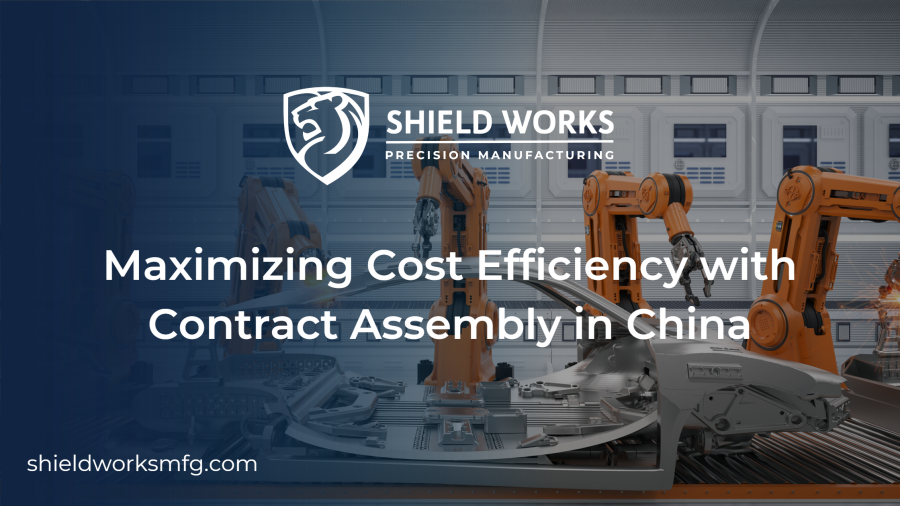
If you’re looking to maximize cost efficiency and streamline your manufacturing process, then you’ve come to the right place. In this article, we’ll dive into the world of contract assembly in China and how it can be a game-changer for your business. By outsourcing your assembly needs to experienced contract manufacturers in China, you can tap into their expertise, infrastructure, and cost advantages to achieve remarkable results. So, buckle up and let’s explore how contract assembly in China can help you boost your business while keeping costs in check!
Why Choose Contract Assembly?
When it comes to manufacturing, time and cost are crucial factors. Contract assembly offers a cost-effective solution that allows you to focus on your core competencies while leaving the assembly work to the experts. By partnering with a reliable contract assembly provider in China, you can save substantial costs associated with infrastructure, equipment, labor, and training.
The Benefits of Contract Assembly in China
1. Cost Efficiency
One of the biggest advantages of contract assembly in China is the significant cost savings it offers. China has a well-established manufacturing ecosystem with a vast network of suppliers, skilled labor, and economies of scale. By leveraging this infrastructure, contract manufacturers can streamline production processes, optimize resource allocation, and negotiate favorable pricing for components and materials. These cost savings can be passed on to you, allowing you to achieve higher profitability and remain competitive in the market.
2. Manufacturing Expertise
China has emerged as a global manufacturing hub, known for its manufacturing expertise and capabilities. Contract assembly providers in China have a wealth of experience in various industries and can handle complex assembly tasks with precision. They possess the technical know-how to tackle challenges efficiently and ensure high-quality output. With their expertise, you can rest assured that your products will be assembled to meet the highest standards of quality and reliability.
3. Scalability and Flexibility
In today’s dynamic business landscape, scalability and flexibility are key to staying ahead of the game. Contract assembly in China offers you the ability to scale your production up or down according to market demand. Whether you need to ramp up production to meet a surge in orders or adjust volumes during slow periods, contract manufacturers can adapt to your needs. This scalability and flexibility provide you with a competitive edge and the agility to respond swiftly to changing market conditions.
4. Reduced Time to Market
Time is of the essence in the business world, and contract assembly can help you accelerate your time to market. By entrusting the assembly process to specialized manufacturers, you can eliminate the need for in-house assembly, which often involves time-consuming setup, training, and coordination. Contract assembly providers in China have established assembly lines, skilled labor, and efficient processes in place, enabling them to deliver products faster and meet your deadlines.
5. Quality Control and Compliance
Maintaining stringent quality control standards is crucial for any business. Contract assembly providers in China understand the importance of quality and adhere to rigorous quality control measures. They implement quality management systems, perform inspections and tests at various stages of the assembly process, and ensure compliance with industry standards and regulations. With their focus on quality, you can have peace of mind knowing that your products will meet or exceed customer expectations.
How to Choose the Right Contract Assembly Partner
Selecting the right contract assembly partner is vital to the success of your outsourcing venture. Here are a few factors to consider when choosing a contract assembly provider in China:
Experience and Expertise
Look for a provider with a proven track record and extensive experience in contract assembly. Assess their industry knowledge, technical capabilities, and the types of products they have assembled in the past.
Quality Assurance
Ensure that the contract manufacturer has robust quality control processes in place. Ask about their certifications, inspection procedures, and commitment to meeting quality standards.
Infrastructure and Capacity
Evaluate the provider’s manufacturing facilities, equipment, and production capacity. Consider whether they have the necessary resources to meet your volume requirements and accommodate future growth.
Communication and Collaboration
Effective communication and collaboration are essential for a successful partnership. Choose a contract assembly provider that demonstrates clear and prompt communication, understands your requirements, and can provide regular updates on the progress of your assembly projects.
Cost Considerations
While cost efficiency is a significant driver for contract assembly, it’s essential to strike a balance between cost and quality. Compare pricing models, explore value-added services, and ensure that the provider offers transparent pricing structures.
You’ve just gained valuable insights into the world of contract assembly in China and how it can help you maximize cost efficiency. By outsourcing your assembly needs to experienced contract manufacturers, you can tap into their expertise, leverage cost advantages, and achieve remarkable results. Remember to carefully evaluate potential partners based on their experience, quality assurance practices, infrastructure, communication, and cost considerations, which make Shield Works you perfect choice with their years of experience and global team members.
So, if you’re ready to take your business to the next level, consider the benefits of contract assembly in China. It’s time to enhance your competitiveness in the market by calling us today!
Collaborating with a Product Assembly Company in China: 10 Factors to Keep in Mind
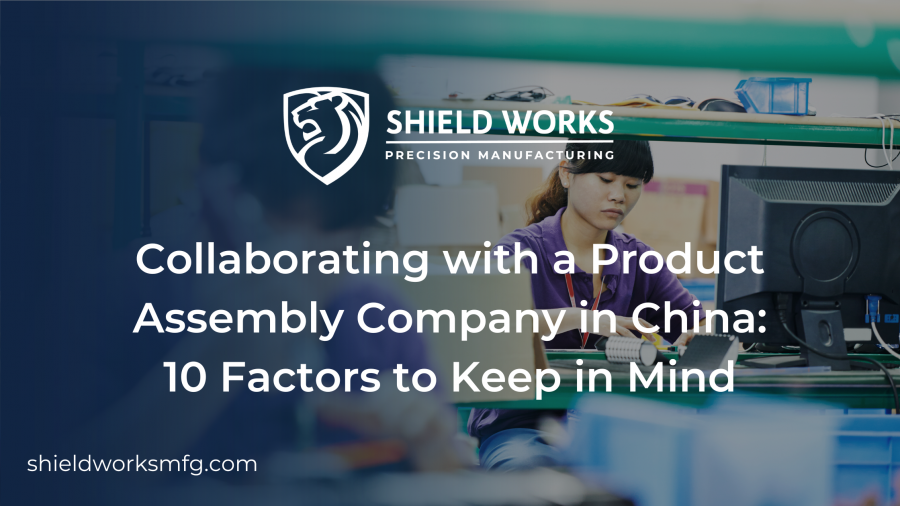
Quality Control: Ensuring Top-notch Products
To achieve a successful manufacturing outcome, it is imperative to ensure that the assembly company produces finished products that meet your standards. Engage in a thorough discussion about the company’s quality control processes and consider visiting their facility to witness their operations firsthand. By doing so, you can ensure that the products align with your specifications and establish clear quality standards to address any issues that may arise.
Lead Times: Factoring in Production and Delivery
Understanding lead times for production and delivery is crucial for effective planning. Consider potential delays that may occur due to holidays or unexpected events. Incorporate adequate time for production and delivery into your project timeline to avoid any disruptions. Additionally, it is prudent to prepare contingency plans to mitigate unexpected delays.
Communication: The Key to a Smooth Working Relationship
Establishing clear lines of communication with the assembly company is vital for a successful collaboration. Designate a point of contact and encourage open dialogue to promptly address any concerns or issues that may arise. Regular check-ins with the company will help you stay informed about the project’s progress and maintain a transparent working relationship.
Costs: Understanding the Full Picture
Comprehending all the costs associated with working with the assembly company is essential. This includes material costs, labor expenses, and any additional fees. Negotiate a fair price and request a written quote to avoid misunderstandings. Moreover, allocate a budget for potential additional costs that may arise during the production process.
Intellectual Property Protection: Safeguarding Your Innovations
Protecting your intellectual property is of utmost importance when collaborating with a product assembly company in China. Ensure that the company has established agreements, such as non-disclosure agreements and intellectual property licensing agreements, to safeguard your innovations. Registering your intellectual property in China provides an additional layer of protection against unauthorized use or disclosure.
Legal Considerations: Navigating the Business Landscape
Navigating potential legal issues is crucial when working with a company in China, as business practices and regulations may differ. Seek legal aid to assist you in understanding contracts, agreements, and regulatory matters. This ensures that your interests are protected and helps you navigate any legal challenges that may arise.
Cultural Awareness: Bridging the Gap
Being mindful of cultural differences fosters a strong working relationship with a product assembly company in China. Show respect for their culture and practices, adapting to different business customs and communication styles. Educate yourself on Chinese culture and customs to better understand the perspective of the assembly company and strengthen collaboration.
Sustainability: Minimizing Environmental Impact
Consider the environmental impact when working with a product assembly company in China. Look for companies that prioritize reducing their carbon footprint and minimizing environmental harm. This aligns with the growing importance of sustainability and can positively impact your customers’ perception. Engage in discussions with the assembly company about their sustainability practices.
Flexibility: Adapting to Challenges
Remaining flexible and open to finding solutions when challenges arise is key to a successful collaboration. Adjust product designs or production timelines to accommodate the assembly company’s capabilities or constraints. This flexibility ensures a smoother manufacturing process and helps overcome potential obstacles.
Payment Terms: Ensuring Fairness and Security
Clearly defining payment terms that are fair and reasonable for both parties is essential. Consider using mechanisms like letters of credit or escrow accounts to provide security and protect yourself in case of disputes. This ensures timely and secure payments for your collaboration.
By carefully considering these ten factors, you can significantly increase your chances of success when working with a product assembly company in China. Establishing clear communication channels, protecting your intellectual property, and working with an experienced assembly company like Shield Works, which boasts its own facility and legal partnerships, will streamline the manufacturing process. Contact us today for more information!
How Assembly in China Streamlines Your Production

Efficiency is an essential aspect when it comes to manufacturing. Companies tirelessly strive to optimize their production processes, aiming to lower expenses and boost output.
One increasingly popular avenue for achieving these goals is through the practice of assembly in China.
But what precisely makes assembly in China a catalyst for streamlined production? To gain a better understanding, let’s delve deeper into the subject.
The Power of Chinese Assembly
When it comes to manufacturing, China has indisputably established itself as a paramount force on the global stage. The nation’s prowess in assembly and production is unparalleled, owing to a multitude of compelling factors.
Indeed, China’s expansive web of exceptionally proficient laborers, cutting-edge facilities, and a flourishing manufacturing ecosystem form an extraordinary amalgamation that is arduous to rival.
This harmonious convergence engenders a veritable whirlwind of efficiency and efficacy, capable of working marvels for your intricate production endeavors.
Quality Control at its Finest
Against common assumptions, Chinese assembly does not compromise on quality in pursuit of quantity.
As a matter of fact, numerous Chinese manufacturers implement meticulous quality control protocols to ensure that each and every product attains global standards. Through stringent examinations and comprehensive testing, they spare no effort in assuring unparalleled excellence.
Reduced Labor Costs
When it comes to producing your products in China, there is a significant advantage in the form of significantly lower labor costs. Chinese factory workers’ hourly wages are much lower compared to those in many other countries.
As a result, this leads to a decrease in your production expenses, ultimately creating the potential for increased profits in your business ventures.
Experienced Workforce
Collaborating with manufacturers in China presents numerous benefits, among which stands out their exceptionally proficient and seasoned workforce. Throughout the years, China has earned a highly esteemed recognition as a dominant force in manufacturing.
Consequently, a vast reservoir of talent, consisting of adept and well-trained laborers, is readily accessible. Their remarkable expertise plays a pivotal role in ensuring the exceptional quality of your merchandise, providing you with an assurance of unparalleled contentment.
Streamlined Supply Chain
Imagine a vivid scene where your production process unfolds seamlessly, akin to a finely tuned mechanism operating flawlessly. This is precisely the remarkable advantage offered by embracing assembly in China.
It entails a harmonious fusion of an extensive array of suppliers and logistical partners, empowering Chinese manufacturers to deftly oversee the entirety of your supply chain with utmost proficiency.
From the intricate task of sourcing raw materials to the final phase of shipping the finished product, their competence spans the entire spectrum, providing you with comprehensive and reliable support at every step of the way.
Access to a Wide Range of Suppliers
China’s vast network of suppliers presents a seamless opportunity for businesses to acquire essential materials and components required for their manufacturing processes.
This distinct advantage simplifies and expedites the typically arduous and costly task of sourcing materials from numerous suppliers spanning multiple countries.
Faster Production Times
China’s extensive network of factories and robust infrastructure allows for remarkably swift production times compared to other nations.
This advantage not only expedites the delivery of your products to the market but also aids in meeting the surging demand with utmost efficiency.
Greater Flexibility
When collaborating with manufacturers from China, one can experience heightened versatility within the production process. An illustrative instance lies in the capacity to swiftly and effortlessly modify product designs or adjust production schedules as needed.
Such agility empowers businesses to effectively respond to market fluctuations, thereby maintaining a competitive edge.
Embracing Innovation
China’s assembly expertise goes beyond mere efficiency and cost-effectiveness; it extends to the realm of innovation. The nation has emerged as a thriving hub for state-of-the-art technology and groundbreaking manufacturing advancements.
Collaborating with Chinese assembly services unlocks a gateway to the latest and most cutting-edge innovations, ranging from automated production lines to highly advanced robotics. Embracing these innovations has the potential to significantly augment your productivity, minimize errors, and drive your business towards remarkable progress.
A Word on Communication
Years into producing for the world, Chinese manufacturers grasp the significance of seamless communication, going above and beyond by employing English-speaking personnel specifically trained to bridge any linguistic gaps.
Furthermore, revolutionary technological advancements have paved the way for effortless remote communication, making collaboration with your Chinese partners a breeze. Rest assured that your production process will sail smoothly, unfazed by any linguistic obstacles.
There are numerous benefits associated with collaborating with Chinese manufacturers to fulfill your production requirements. Not only can assembly in China lead to decreased labor expenses, but it can also expedite production timelines, thereby streamlining your overall manufacturing process and providing you with a competitive advantage in the market.
If you are contemplating the prospect of engaging with Chinese manufacturers, it is imperative to conduct thorough research and select a reputable partner. It is advisable to seek out a company with a well-established track record of accomplishments, as well as a steadfast dedication to upholding quality standards and ensuring customer satisfaction.
This is precisely what Shield Works embodies. With 18 years of invaluable experience in facilitating the outsourcing of assembly for Western enterprises to the Far East, Shield Works stands as the optimal choice for forging successful partnerships. Feel free to reach out to us today!
